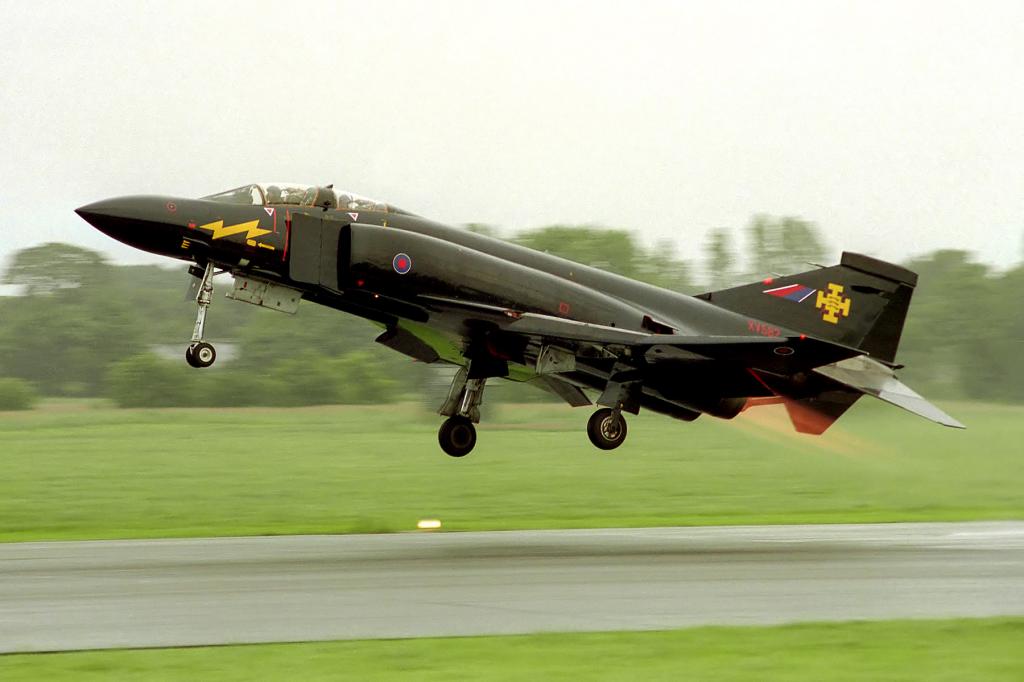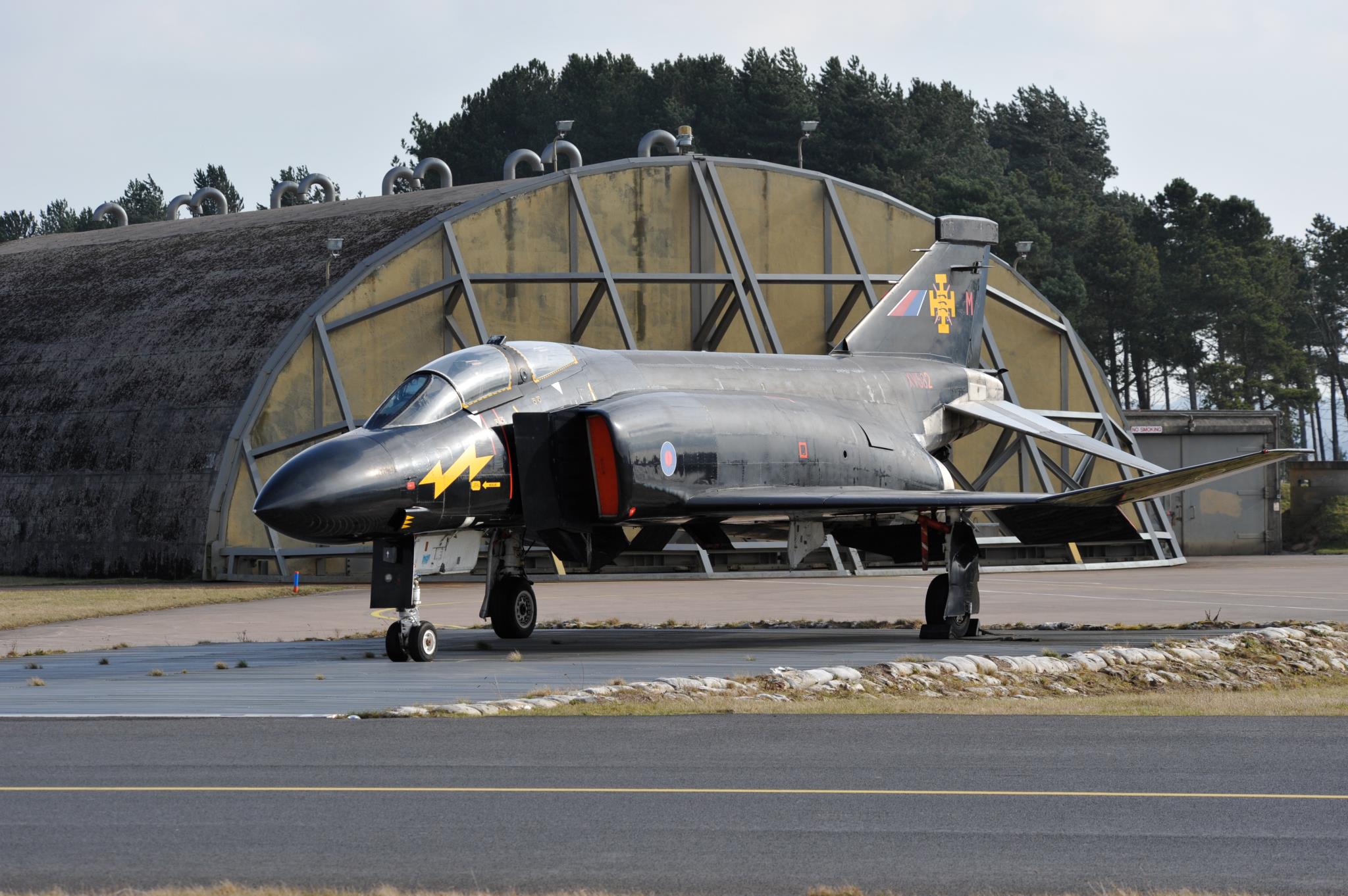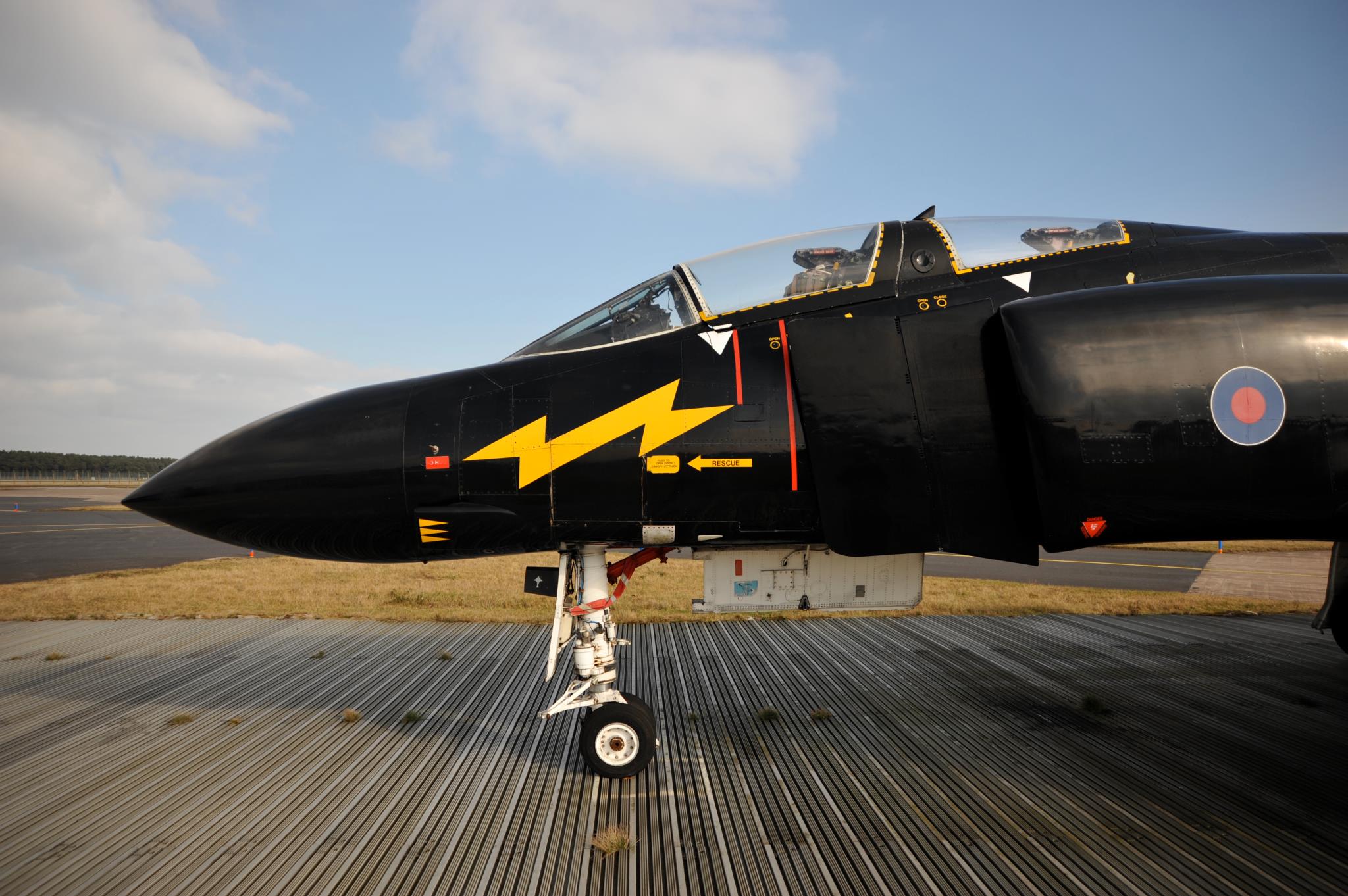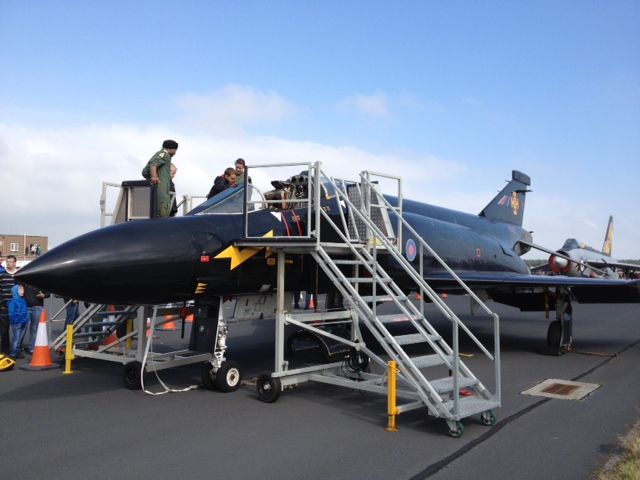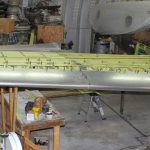WarbirdsNews believes strongly in championing the preservation of vintage aircraft whenever possible, and has learned of a historic RAF McDonnell Douglas Phantom II nicknamed “Black Mike” which needs our support. There is an organization in the UK called The British Phantom Aviation Group which is trying to secure its survival, and one of it’s members, Sam Thompson, has sent us a terrific article about the aircraft and what his group is attempting to achieve regarding its preservation. We hope you will enjoy reading more…
Sam Thompson is currently serving as an Armourer with the Royal Air Force, and he now picks up the story here….
Sadly the F-4 Phantom II was out of service before I joined up, but they played a big part in my parents’ lives as they both served in the RAF working alongside the aircraft. During my spare time I am the General Secretary of The British Phantom Aviation Group (BPAG). BPAG formed early in 2013 from an idea by Phil Moore, Justin Keeble and David Butterfield. Our purpose was to share common thoughts, experiences, photographs and knowledge on all British-operated McDonnell Douglas F-4 Phantom variants.
The British Phantom Aviation Group as a whole would like the chance to maintain and preserve to the highest standards what is strongly believed to be the most iconic F-4 Phantom II in the Royal Air Force’s history, FG.1 XV582. Known as “Black Mike” due to her distinctive all-black livery, this aircraft’s future is currently in doubt due to the impending closure of RAF Leuchars in Scotland, where she currently serves as a gate guardian.
But first a little history on the Phantom II in British service…
The United Kingdom bought versions based on the U.S. Navy’s F-4J for use with both the Royal Air Force and the Royal Navy’s Fleet Air Arm. The main differences with the US models were the use of the British Rolls-Royce Spey engines and also British-made avionics. The RN and RAF versions were given the designation F-4K and F-4M respectively by the manufacturer, and entered service with the British designations Phantom FG.1 (fighter/ground attack) and Phantom FGR.2 (fighter/ground attack/reconnaissance).
Initially, the FGR.2 took on the ground attack and reconnaissance role, primarily with RAF Germany, while 43 Squadron formed in the air defence role with the FG.1s that had been intended for Fleet Air Arm use aboard HMS Eagle before she was retired. The superiority of the Phantom over the English Electric Lightning in terms of both range and weapon load, combined with the successful introduction of the SEPECAT Jaguar, meant that most of the ground attack Phantoms in Germany were redeployed to the UK to replace air defence Lightning squadrons during the mid-1970s. During the Falklands War in May/June 1982, three Phantom FGR2s of No. 29 Squadron were on active Quick Reaction Alert duty on Ascension Island to protect the base from potential air attack. After the war ended, fifteen upgraded ex-US Navy F-4Js, known as the F-4J(UK) entered RAF service to compensate for one interceptor squadron which re-deployed to protect the Falklands.
No. 6 Squadron at RAF Coningsby was the first squadron to receive their Phantoms in July 1969. Overall, around fifteen RAF squadrons operated various marks of the Phantom II; many of them based in Germany. Remarkably, No. 43 Squadron held onto their Phantom FG.1s at RAF Leuchars for nearly twenty years; flying the type between September 1969 and July 1989.
The Panavia Tornado F.3 replaced Phantoms in the interceptor role from the late 1980s onwards, and the last British Phantoms retired in October 1992 when No. 74 Squadron disbanded.
And this is when “Black Mike” steps into the frame…
It was during the twilight years of RAF Phantom service that the idea of a black Phantom arose. The proposal was initially mooted prior to 111 Squadron’s 70th anniversary in 1987. They had famously flown as an aerobatics team during the 1950s with all-black Hawker Hunters known as The Black Arrows. It was Wing Commander Terry Hanlon, however, who made the move in the late spring of 1989. The basic plan was to have an all-black aircraft to celebrate both the 30th anniversary of Treble-One’s “Black Arrows” and mark the final years of FG.1 service.
Treble One’s Hunters had worn a simple gloss black scheme with just the national insignia and fin flashes for adornation, but the sheer size of a Phantom’s tail compared to a Hunter had caused a re-think of how to paint the aircraft The design team decided that Treble One’s official “crossed swords” emblem should go on the fin and some form of marking on the nose, which ended up being a golden lightning bolt.
Treble One selected FG.1 XV582 to receive the special paint job. This particular Phantom was quite significant itself. On 24th Feb 1988, XV582 became the first RAF Phantom to pass 5,000 flying hours. This milestone occurred during its record-breaking 46minute 44second run from Britain’s southern most point at Land’s End in Cornwall to it’s northern-most point at John O’Groats in Scotland. 43 Squadron’s CO, Wg Cdr John Brady with navigator Sqn Ldr Mike Pugh made the 590-mile flight which averaged out at over 757mph.
RAF Leuchars’ paint crew spent many hours rubbing down the previous layers of green and grey camouflage on XV582 to get a good smooth surface for the undercoat. They then applied the shiny finish as well as the various statutory and special markings to the aircraft, including its squadron code M for ‘Mike’. “Black Mike”, as XV582 became known, made her debut at the press review before the RAF Leuchars Open Day on September 23rd, 1989. Originally, “Black Mike” was to sit on static display at the show, and revert back to standard Phantom fleet markings afterwards, but the public’s intense fascination with the aircraft changed these plans. The supreme accolade came from the Commander-in-Chief of RAF Strike Command, Air Marshal Sir Patrick Hine, himself an ex-Black Arrow. He said he wanted to fly it!
Photographs rapidly appeared in the aviation press and the RAF soon realized that the aircraft offered considerable PR benefit. Although its operational life was finished, there was still a modest 50 hours of fatigue life remaining on her books, so the RAF decided to use ‘Black Mike’ as a fund raising attraction at various air shows within the UK during the following year.
To this end, Flight Lieutenant Gordon Moulds, an instructor with 228 Operational Conversion Unit at Leuchars, flew “Black Mike” to over a dozen displays during the summer. After “Black Mike” used up her airframe hours, 111 Squadron placed her on gate guardian duties outside their facilities at RAF Leuchars. The Phantom stayed there until Treble One’s disbandment on March 22nd, 2011, after which she moved into storage in one of Leuchar’s Hardened Aircraft Shelters.
Even so, ‘Black Mike’ still joined the static park giving cockpit tours during the station’s annual airshow. This tradition continued up until September 2013, when the RAF announced that this would be the final air show at Leuchars due to the station’s impending closure and transfer to British Army ownership.
Currently ‘Black Mike’ is still stationed at RAF Leuchars, both outside and under cover. The station’s Visiting Aircraft Section looks after her, but she faces an uncertain future once the British Army claims the base. It must be stressed that very few complete ex-RAF Phantom II’s remain of the 173 or so examples procured. The British Ministry of Defense has allowed very few of them to survive the scrapper’s torch, so it is imperative that every effort be made to save XV582.
The British Phantom Aviation Group plan to get XV582 relocated to Bruntingthorpe in Leicestershire, which has a very active vintage jet community. XV582 could be preserved there for many years to come, and has the potential of becoming a live running example, as are many other ex-RAF jets at Bruntingthorpe, performing fast taxis down the runway before a public audience.
Any enthusiasts and followers who wish to help us save “Black Mike” can learn how to do so via our websites: www.xv582blackmike.co.uk which is dedicated to XV582, or The British Phantom Aviation Group (www.britishphantomaviationgroup.co.uk). Many thanks for any help you can provide!







